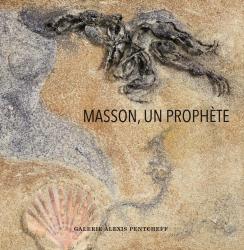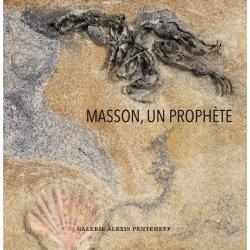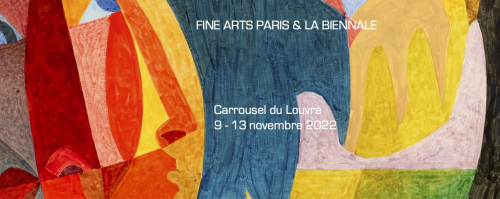Originally from the Oise region, André Masson's family moved to Lille where the young boy had his first encounter with painting at the city's Museum of Fine Arts. But it was in Brussels, where the family then lived, that his apprenticeship began. In Constant Montald's studio, at the Academy of Fine Arts, he met the Belgian poet Emile Verhaeren, who decided to send him to Paris, on his recommendation.
Wishing to study fresco, he joined Paul Baudouin's studio at the Beaux-Arts de Paris and assiduously attended the Louvre and the Musée du Luxembourg. He obtained a travel grant to study monumental painting in Tuscany where he went with his friend Maurice Loutreuil.
The war broke out and Masson enlisted in the infantry. He was seriously wounded during the Chemin des Dames offensive and spent long periods in hospital. At the end of the war, he joined Loutreuil near Martigues and spent a few months in an abandoned cottage on the Etang de Berre, where he really began to paint.
Then he went to Céret where he stayed between 1919 and 1920, living a bohemian life from day to day. He painted many landscapes inspired by the power of Cézanne and met Odette Cabalé whom he married in February 1920. The couple gave birth to a daughter, Lily, and moved to Paris, in the Montmartre district, where Masson worked at a number of small jobs: glass deliveryman, ceramic decorator, printer's proofreader... But he was soon able to devote himself to painting thanks to the contract he had just signed with the Kahnweiller gallery.
The 1930s: surrealism, massacres, sand paintings
From 1923, he rented a studio on rue Blomet, in the 15th arrondissement, which Artaud, Leiris, Limbour and Miro (his neighbor) regularly frequented, as well as Ernest Hemingway, Roland Tual, Armand Salacrou, Antonin Artaud, Robert Desnos, Gertrude Stein and Max Jacob. He also met André Breton and Aragon.
In February 1924, his first solo exhibition took place at the Galerie Simon (Kahnweiller).
The same year, he joined the newly formed Surrealist group and developed the first automatic drawings.
In the spring of 1926, the painter moved to Sanary-sur-mer and created his first sand paintings. He stayed there for a year and then returned to Paris, after traveling to Holland and Germany.
The year 1928 marked a break for the painter, both in his life and in his practice: on the one hand he gradually moved away from the Surrealist group and on the other hand he divorced Odette.
Through the writer Kino Matsuo, he discovered the Zen doctrine and Buddhism, which would influence him greatly.
He worked in the slaughterhouses of La Villette and then in those of Vaugirard, from which he drew works that showed suffering in a very crude way and became more interested in the fate of animals, which became one of his favorite themes.
In 1932, he spent the whole year in the South of France, near Grasse and regularly met Matisse. He created his first theater sets for the Ballets Russes.
Back in Paris in the winter of 1933, he collaborated with the surrealist magazine Minotaure. He is also the official illustrator of the magazine Acéphale founded by Georges Bataille. He met Rose Maklès, sister of Sylvia Bataille, who became his companion.
With her, he travels on foot through Andalusia and finally settles in Tossa de Mar. The couple got married and welcomed their first son. The myths, the bullfight, the violence and cruelty, which are in the mind of the painter intimately linked to Spain, fascinate him. But the situation in the country became unstable and when the war broke out, the family, which had welcomed a second child, returned to live in France.
Settled in Normandy, Masson resumed close contact with the Surrealist group and participated in the International Surrealist Exhibition in London and then in "Fantastic Art, Dada, Surrealism" at the Museum of Modern Art in New York.
Masson's American exile during the Second World War
Fleeing Normandy under the pressure of the German advance, Masson and his family spent some time in Auvergne at the home of Georges Bataille before reaching Marseille, where they waited, like other intellectuals and artists, to embark for the United States thanks to the intervention of Varian Fry and the American Rescue Committee.
After a stopover in Martinique, the Massons disembarked in New York in May and began a life of exile that would last four years. The family finally settled in Connecticut, in New-Preston, New England.
Among their neighbors were Alexander Calder, Arthur Kemp and Arshile Gorky. The painter also met André Breton, Marc Chagall, Georges Duthuit, Yves Tanguy...
The Baltimore Museum organized a retrospective of his work (the first to date) and invited him to give a lecture on the origins of Surrealism. Masson was a great inspiration to the young American abstract expressionists, especially Jackson Pollock. In America, he focused on a pictorial transcription of elemental forces, of telluric mysteries. He was inspired by the unique landscapes and the art of the Indians.
The activity of the surrealists in exile is great and he participates in it. But in 1943, the painter broke definitively with André Breton, then with the surrealist group.
From 1944, his paintings became extremely "calligraphic".
Masson's Asian and Aix period
In October 1945, Masson could finally return to France. He first settled in Paris, then more quietly in the vicinity of Poitiers.
In 1947, he moved to the South of France, to Le Tholonet, near Aix-en-Provence.
The countryside of Aix inspired him. It was also the beginning of his "Asian" period.
In 1950, a retrospective of his work was organized at the Kunsthalle in Basel, with Giacometti.
The following year, Masson went to Venice for the first time, where he would return regularly.
In the 1950s, his painting was variously inspired by an unusual evocation of the landscape on the one hand and, on the other, by a return to the observation of city life. He returned to the Paris that had once seduced him, creating the "Feminine" series in the rue Saint-Denis and returning to the butchers of the Halles. During this period, he also wrote several articles.
He moved back to Paris for part of the year, first to rue Sainte-Anne, then to rue Sévigné in the early 1960s. He was chosen to paint the dome of the Odéon.
In Marseille, an exhibition was held at the Cantini Museum in 1968 and for the artist's 80th birthday, the Museum of Modern Art, New York, the Museum of Fine Arts in Houston and the National Museum of Modern Art in Paris paid tribute to him.
Masson stopped painting in the early 1980s, as his health no longer allowed him to. He died in October 1987.
André Masson is one of the most important painters of the 20th century.
His involvement in the Surrealist movement, his American experience and more generally his singular approach to painting, make him one of the necessary links between pre-war painting and the art of the second half of the 20th century. During his lifetime, his reputation was very great, with many institutions recognizing his talent and his immense contribution to painting.

masson.
un prophète.
Giulia Pentcheff
| Publication year | 2022 |
|---|---|
| Number of pages | 144 |
| Format | 21 x 21 cm |
| ISBN | 9791094462126 |

masson, un prophète
Giulia Pentcheff
| Publication year | 2022 |
|---|---|
| Number of pages | 144 |
| Format | 21 x 21 cm |
| ISBN | 9791094462126 |


